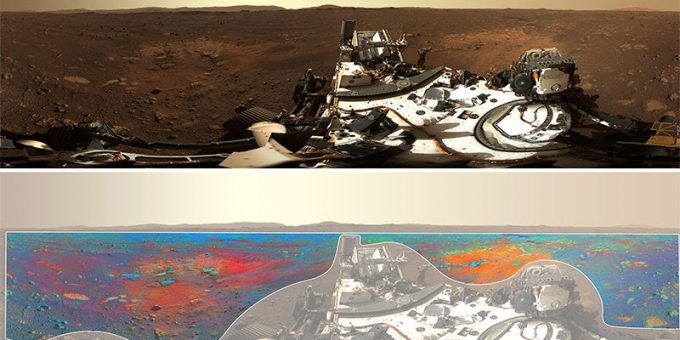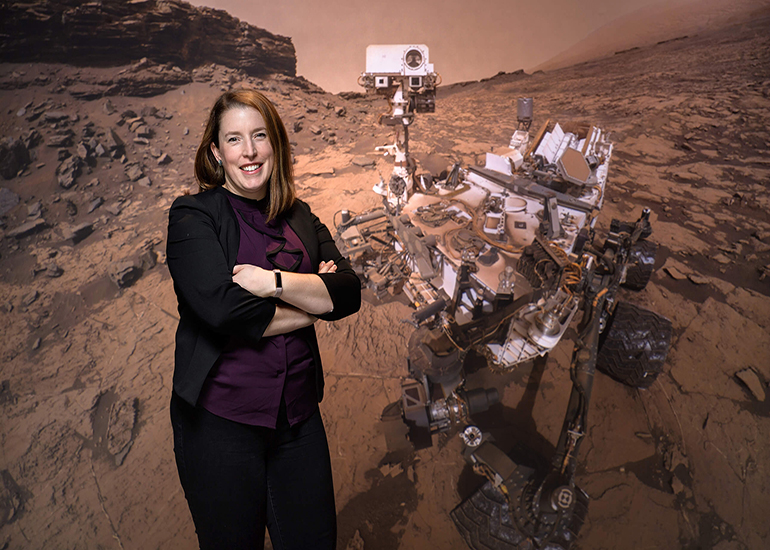
WEST LAFAYETTE — Almost one year into the Mars rover mission, accomplishing its goal is on the horizon for Purdue University’s Briony Horgan and the Perseverance team.
Feb. 18 will mark one year since the rover landed on the red planet following a seven-month, 300-million-mile flight across space.
Horgan, associate professor of planetary science in the Purdue College of Science’s Department of Earth, Atmospheric, and Planetary Sciences, said anticipation is building as the team focuses on the mission goal: researching a now-dry large river delta.

“When we chose the landing site, it was because of the delta; that’s the reason we’re here,” Horgan said. “So, we’ll be excited to finally get up close and study it.”
Horgan has been involved with several aspects of this mission. She led mineralogy research using satellite data before landing, and her team produced one of the major results on the location that contributed to NASA’s selection of Jezero Crater – which once held a lake and the river delta – as the landing site.
“We’ll spend most of the next year on the delta, exploring this ancient lake and river environment and looking for signs of ancient life-like organic material and signs of microbes,” she said.
The mission is intended to last three years as the Mars rover collects rock and dust samples. Horgan said that after the three-year point, the hope is Perseverance will continue outside Jezero Crater for as long as possible.
Horgan is now the long-term planner as part of the science leadership for NASA’s Perseverance Mars rover, helping guide the mission strategy and scientific investigations. She discusses the rover mission on an episode of the “This Is Purdue” podcast.
While the key objective for the rover is searching for signs of ancient microbial life by examining the planet’s geology, there’s been a learning curve to the first year of work. Once the rover began to traverse the landscape, things were deliberate, with 12-15 hours of travel taking just as long to plan.

As the second year approaches, Horgan said the team is hoping to step away from that semi-autonomous travel.
“With all the new technology on the rover, we’re working on how to drive on consecutive days and do longer and longer autonomous drives,” she said. “Then we’ll make a beeline for the delta as fast as we can.”
Horgan said the mission already has proved both fruitful and surprising with the Mars rock and atmosphere samples collected. A layered ridge spotted after landing was initially expected to be sedimentary rock that could hold biosignatures from the planet’s past.
Closer inspection, Horgan said, found that it was an ancient lava flow, but one that could still provide answers with the sample drilled from it. The same rocks are believed to underlie the delta and can be eventually examined for dating.
“By doing that, we can actually figure out when the delta was there and when there was water in the crater,” Horgan said. “That’s a really big question because we only have estimates for when we think Mars was wet and was habitable. We really don’t know for sure.”
Horgan said the mission remains on track and has already surpassed the work of the Mars rover Curiosity, which was launched in November 2011. Four unique rock and dust samples are expected to be collected by next month’s landing anniversary.
“It’s an incredibly ambitious mission, with goals that are leaps and bounds beyond any previous Mars rover and really any previous space mission had been supposed to do: how far and fast we’re supposed to drive, how many samples we are supposed to drill …,” Horgan said. “We’re still learning a lot.”



